Highlights
from the recent catalogue
Graphic Alchemy
Click
on a thumbnail (above) to link
directly with the entry for that print,
or scroll
down to view this selection from
the Graphic Alchemy catalogue.
Images are not at very high resolution.
If you require further information on any print featured here, please contact
us. Some
of these prints - and others from the catalogue,
have since been sold,
and are marked " Sold ".
Click
these links to
view selections of prints from other recent
catalogues:
"The
Romantic Eye" and "Every
Picture tells a Strory" |
|
See
also :
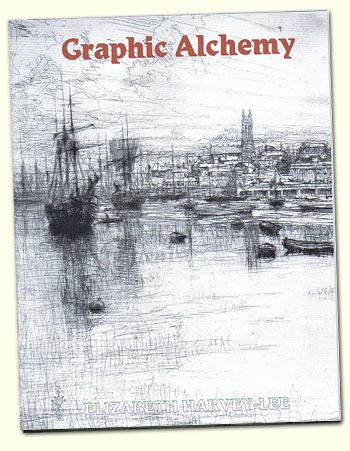
For
further information about Graphic Alchemy, please view the dedicated
page within the Catalogues section.
Printed copies of the Catalogue, published
in summer 2010, are still available, priced
£10.
|
|
|
|
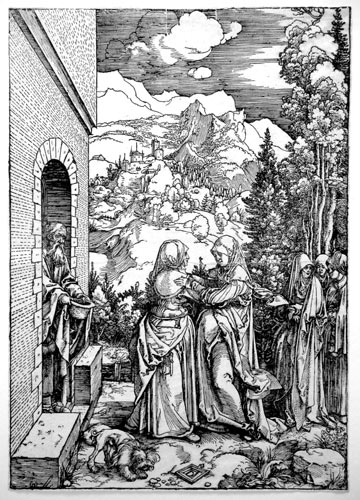 |
|
ALBRECHT DÜRER
Nuremberg 1471 – 1528 Nuremberg
Dürer began the woodcuts for ‘The Life of the Virgin’ in 1503, though they were not published as a complete series of seventeen till 1511, when they were printed with Latin text to the reverse.
The
blocks continued to be reprinted without
(‘after’) text until about 1600, during which time a number of small gaps developed in the borderlines, and sometimes occasional wormholes, cracks etc.
However the two major cracks at the top of the block of The
Visitation had developed already even before the 1511 edition.
The
Visitation
Bartsch 84; Plate 9 of ‘The Life of the Virgin’
300 x 211 mm
Woodcut,
c1504.
With the monogram.
A later impression,
after text but still printing clearly.
A
horizontal printing crease through the chins
of the two pregnant Marys. Other minor defects.
Watermark: shield with a diagonal bar.
Sold
Return to top
^ |
|
|
|
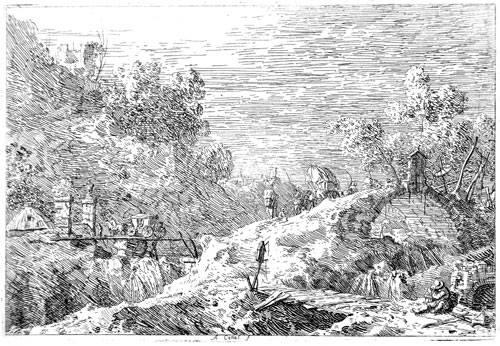 |
|
GIOVANNI ANTONIO CANALE
called IL
CANALETTO
Venice
1697 – 1768 Venice
Mountain
Landscape with five Bridges
Bromberg 22 iiA/iiB
143 x 210 mm
Original
etching. The plate signed.
Second state,
with the extra work, particularly at the
right of the plate, to increase tonal contrast
and clarify the forms of the bridge immediately
behind the sleeping pilgrim and that arching
high above him.
With little evident wear
to the plate.
On cream laid paper, with margins.
Part
of a Three Crescents watermark.
£6750
Canaletto
made a number of capriccio landscapes during
his earlier period, 1730-1741, imbued with
an airy lightness of touch, the very essence
of the rococo.
Return to top
^ |
|
|
|
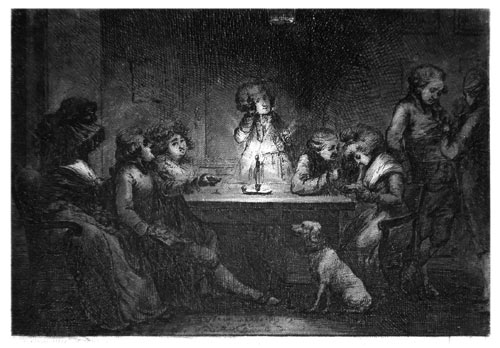 |
|
Baron DOMINIQUE VIVANT-DENON
Givry,
near Chalon-sur-Saône 1747 – 1826 Paris
A
Gathering at a Table by Candlelight
IBN 23
iv/iv
139 x 212 mm
Original
etching with mezzotint, 1780-92.
The
plate signed, and with the number 33B.
On
wove paper.
Sold
Successively
a law student, comic playwright, and up to
1787 a diplomat, Denon spent much time in
Italy, where he took up etching and engraving
with some success.
On
a brief return to Paris in 1787 he was elected
to the Académie Royal de Peinture.
This
little candlelit ‘conversation piece’ was probably engraved in in the years prior to the outbreak of the French Revolution, either in Naples - where Denon was French Chargé d’Affaires 1782-85, or in Rome - where he passed the years 1785-87 or at Venice, to which city he moved in 1788.
Denon
would return to Paris in 1793, under the
protection of the painter Jacques-Louis David.
He became an habitué of the Salon of Madame
de Beauharnais, where he met Napoleon. Bonaparte
invited him to join the expedition to Egypt
in 1798 as draughtsman, and subsequently appointed
him Director of the new museum of the Louvre,
a post Denon held from 1804 to 1815.
He
was equally important in being the first
French artist to take up the newly invented
technique of lithography.
Return to top
^ |
|
|
|
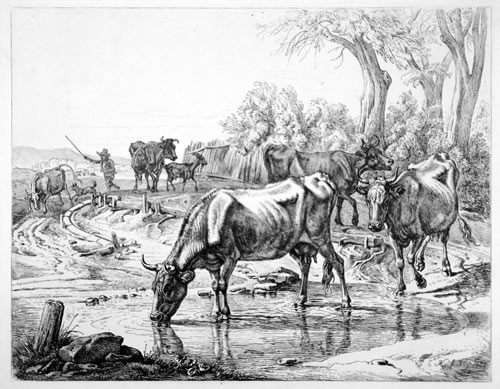 |
|
JOHANN ADAM KLEIN
Nuremberg
1792 – 1875 Munich
Klein
had early and continuing success as an etcher,
publishing his first prints at the age of
nineteen, in 1811.
Typical
of German artists of the Romantic period
he made many walking and sketching tours
which supplied subjects for his etchings.
His journeying included the traditional visit
to Rome, where he stayed from 1819 to 1821.
He
returned to Nuremberg, which remained his
base until 1839, when he moved to Munich.
He etched some 366 plates.
Herd
watering
184 x 234 mm
Original
etching, 1829.
The plate initialled and dated.
On cream wove.
£250
Return to top
^ |
|
|
|
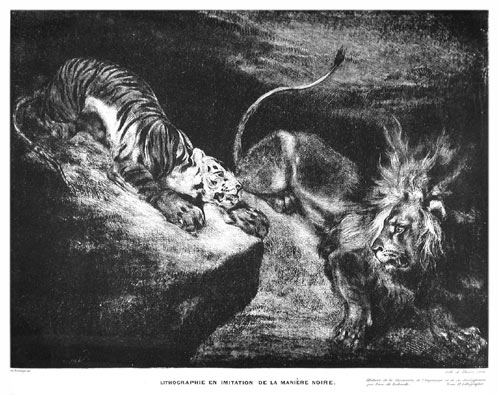 |
|
LOUIS BOULANGER
Vercelli,
Piedmont 1806 – 1867 Dijon
Painter,
lithographer and poet, Boulanger was active
in the French Romantic movement. He was a
close friend and associate of Victor Hugo.
Tiger
confronting a Lion
227 x 306 mm (image);
275 x 358 mm (sheet)
Lithograph,
lettered with the artist’s name, the title Lithographie
en imitation de la manière noire (Lithograph
in imitation of a mezzotint) and the details of the book* on the history of printmaking for which it was commissioned as an illustration and example of the versatility of lithography as a medium. On wove. Foxed and time-stained in the margins.
Sold
In
this bravura romantic image Boulanger has
successfully recreated both the tonal effect
and the texture of mezzotint.
*
Histoire de la Découverte de l’Impression et de ces
 Développements by
Léon de Laborde, Tome
17: Développements by
Léon de Laborde, Tome
17:
 “Lithographie”. “Lithographie”.
Return to top
^ |
|
|
|
 |
|
HIPPOLYTE FAUCHON
French
painter and lithographer, exhibiting at the Salon
from 1877
A
Lithographic Studio
250 x 195 mm
Lithograph
1891. The stone signed and dated.
Published
in the second, or more probably, third album
of the ‘first’ Estampe Originale *.
With the stamp (Lugt 887a), printed recto in violet.
Numbered 21 in pencil. Probably from an edition
of about 50.
Impressions from the series are rare.
On
thin japan with ‘laid’ lines.
Sold
A
fascinating glimpse of artists at work drawing
on lithographic stones supported on sloping
desks.
*L’Estampe Originale, 4 rue des Petits-Champs, Paris, was established by the director of the Société of the same name to publish small editions of artist members’ original prints.
The first ‘album’ appeared in May 1888, the second between 1888 and 1891 and the third, and final, album in May 1891.
The publication is little known and the prints published in it are of extreme rarity.
(Two years after it ceased, André Marty, 17 rue de Rome, Paris, adopted the same title, or purchased the right to use it, for his own series of nine albums of artists’ original
prints, which he published in nine instalments
1893-95.)
Return to top
^ |
|
|
|
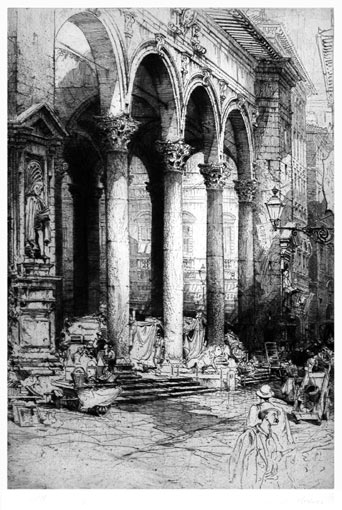 |
|
HEDLEY FITTON R.E.
Didsbury,
Manchester 1857 – 1929 Haslemere
Fitton
travelled and worked extensively in England,
Scotland, France and Italy etching, with
a sympathetic and knowledgeable eye, many
of the most admired architectural landmarks,
which he exhibited widely.
The
Flower Market, Florence
Fuller pp 52-53
355 x 240 mm
Original
etching, 1904.
Signed in pencil and entitled.
Edition of 100.
Edge-mounted
inside a sealed mount.
£600
The
Mercato Nuovo or Straw Market, known locally
as Il Porcellino. An impression was exhibited
at the R.E. in 1904.
Return to top
^ |
|
|
|
| |
|
|
|
|
THOMAS DAVID HAMSON
Walsall
1890 – 1964 Coventry
A
little known etcher, Hamson was second master
at Coventry School of Art in 1914, when,
after the outbreak of war, as a conscientious
objector, he was forced to resign.
In
the 1920’s he turned to commercial work, and etching, travelling the countryside making pencil and crayon studies which he etched in his studio. He drew inspiration from his collection of old master prints and had a particular admiration for Rembrandt and Whistler.
He
became interested in the Theosophical Society
before becoming a Buddhist, living frugally.
Later as a recluse, he was supported by the
friendship of a silversmith, Winifred King,
whom he had known since student days, and
at the end of his life by a young artist,
Howard Watson.
Gypsy
Caravan
137 x 214 mm
Original
etching. An unsigned proof. On japan.
Provenance:
Howard Watson.
£85
Old
Palace Yard (the artist’s
studio)
135 x 214 mm
Original
etching. An unsigned proof. On japan. Provenance:
Howard Watson.
£75
Return to top
^ |
|
|
|
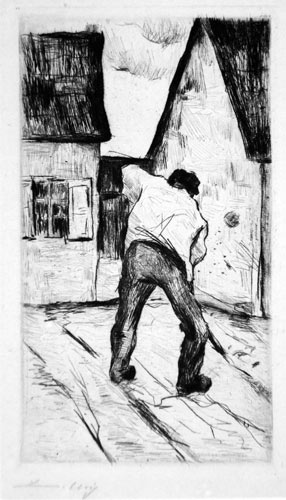 |
|
LESSER
URY
Birnbau
1861 – 1931 Berlin
After
study periods in Düsseldorf, Brussels, Paris, Stuttgart and Munich, the German Impressionist painter settled in Berlin in 1901 and exhibited with the Berlin Secession.
His
favourite themes were of Berlin city life;
rural subjects are less typical.
Grabender
Bauer - Dutch peasant digging
Rosenbach 102
178 x 102 mm
Original
drypoint, 1920. Signed in pencil.
Total edition
of 130. One of 100 on cream wove.
A little
time-stained.
£1000
Return to top
^ |
|
|
|
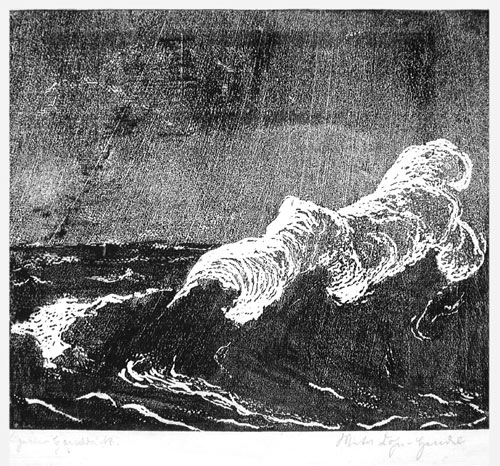 |
|
GERMAN SCHOOL – MARTEN LOJN-GAURE?
A
big Wave
244 x 282 mm
Original
hand-printed relief print.
Signed (illegibly)
in pencil and annotated in German.
On japan
paper with laid lines.
Unobtrusive handling
defects, mainly in the margins.
£450
Return to top
^ |
|
|
|
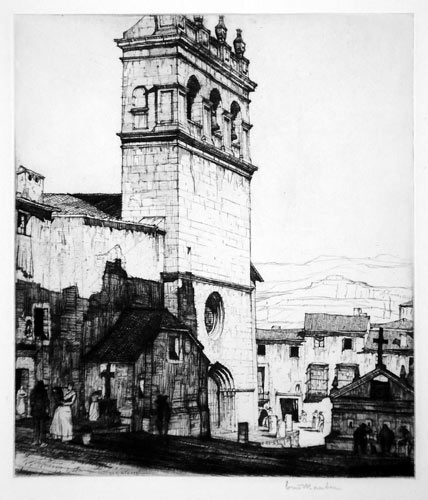 |
|
LOUIS ROSENBERG A.R.E
Portland,
Oregon 1890 – 1983
Rosenberg
trained as an architect in Oregon. He graduated
in 1914, and won a travelling scholarship
to Europe. However, the outbreak of the First
World War postponed the opportunity, though,
in another capacity, he went to France in
1917 for two years, serving in the American
army in the Camouflage Corps of the 40th
Engineers.
After
the war, newly married, he returned to Europe
on his scholarship in 1920. At the American
Academy of Rome, in 1921, Rosenberg discovered
etching, under the guidance of the American
etcher Robert Fulton Logan.
In
Rome Rosenberg also met William
Walcot, another
architect-etcher, who introduced him to his
own publisher H.W. Dickins.
At
the end of his scholarship in 1922 Rosenberg
returned to architectural practice in Oregon
but continued to etch in his spare time.
It
was probably as a result of seeing an illustration
of one of Rosenberg’s plates in Fine
Prints of the Year, 1924, that Muirhead Bone advised the American to become a full-time etcher.
He
returned to Europe to attend the Royal College
of Art classes of Malcolm Osborne in 1924
and in the following three years travelled
widely on the continent finding architectural
subjects to etch.
Santa
Cecilia, Guadelupe, Spain
208 x 176 mm
Original
drypoint, 1926. Signed in pencil.
The plate initialled and dated in roman numerals.
Printed
in brown-black ink on cream laid paper.
£325
Return to top
^ |
|
|
|
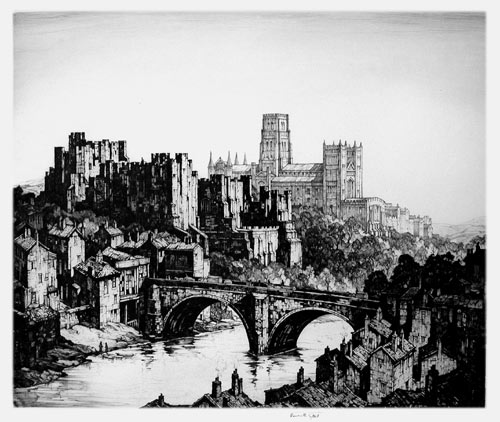 |
|
KENNETH STEEL
Sheffield
1906 – 1973
A
watercolour painter, poster designer, and
printmaker, Steel trained at Sheffield College
of Art. He did a great deal of artwork for
the railways, particularly the LNER.
This
etched view of Durham was probably taken
from the railway station which is high up
above the city and offers a splendid panoramic
view.
Durham
302 x 354 mm
Original etching & drypoint, 1935.
Signed in pencil.
Edition of 60.
Printed in brown-black ink on cream wove.
Sold
Return to top
^
|
| Click here to
view a selection of prints from
"The
Romantic Eye" catalogue |
|
|
|
|
|
|